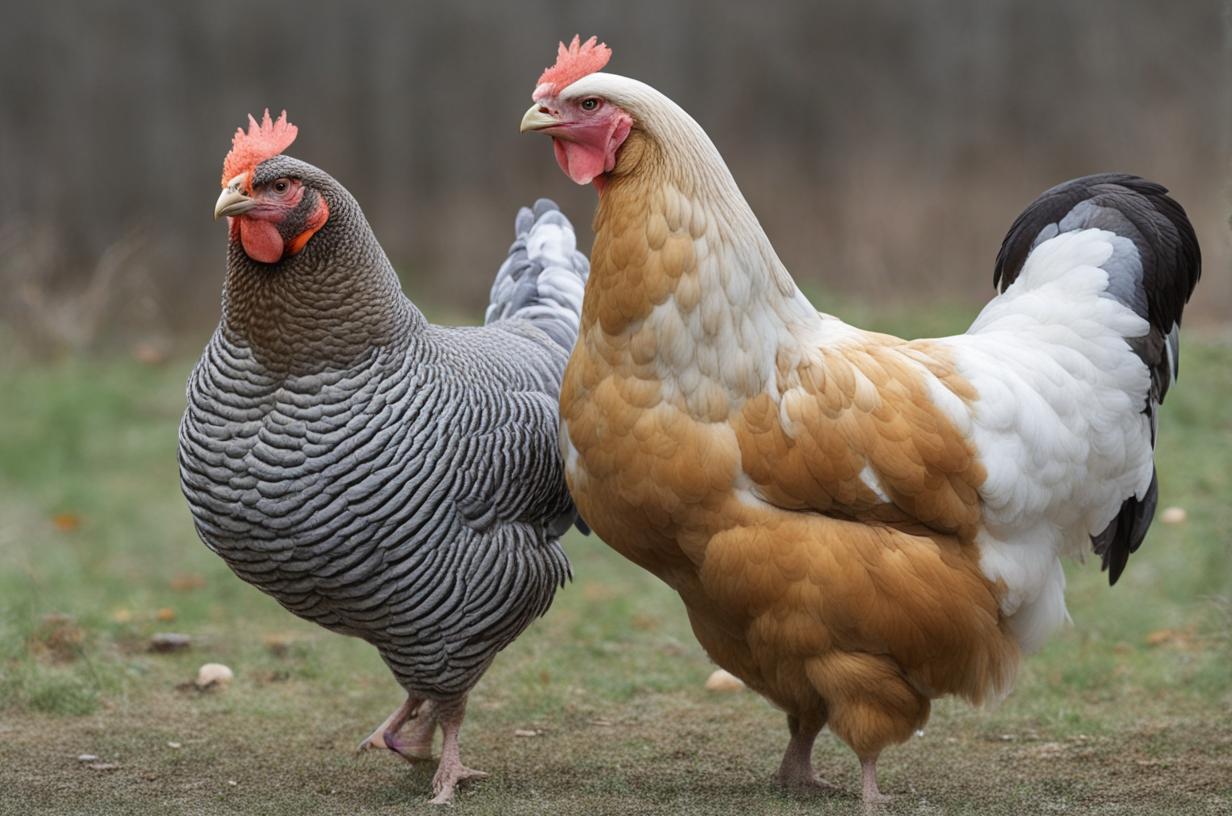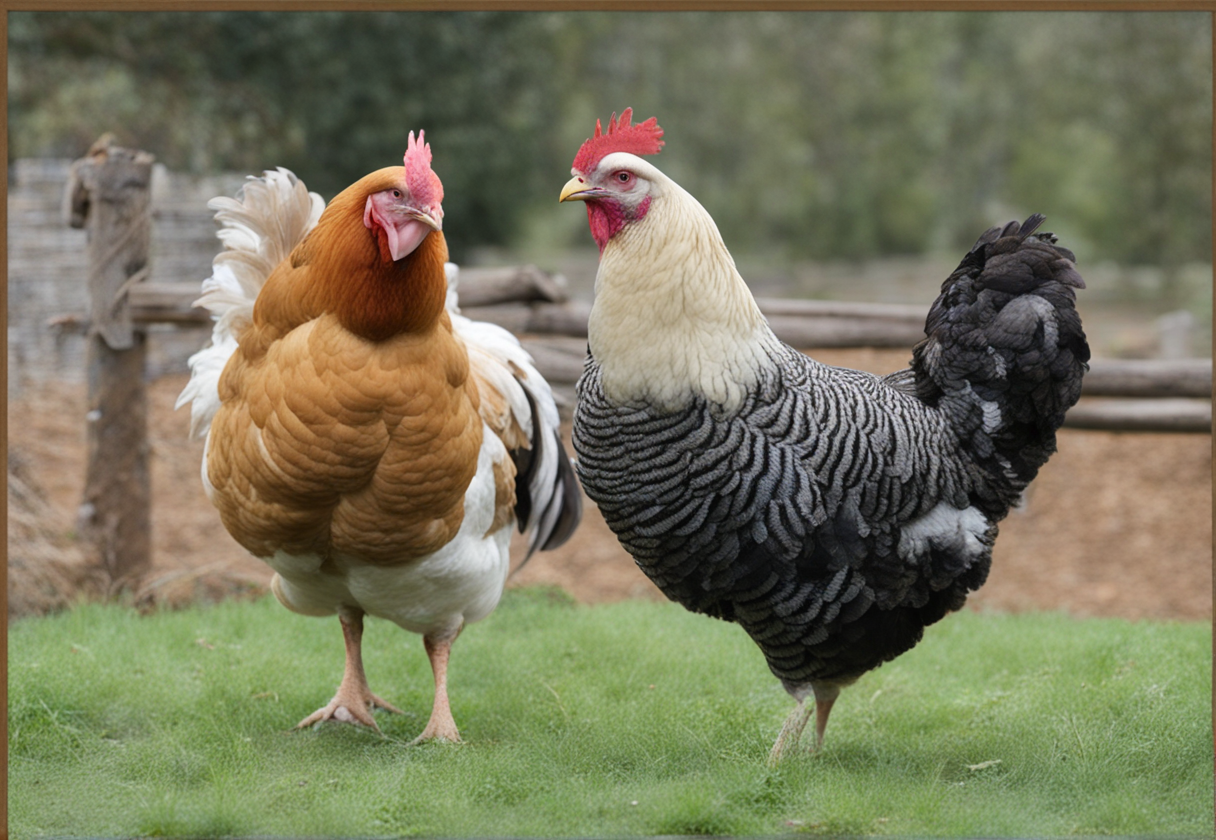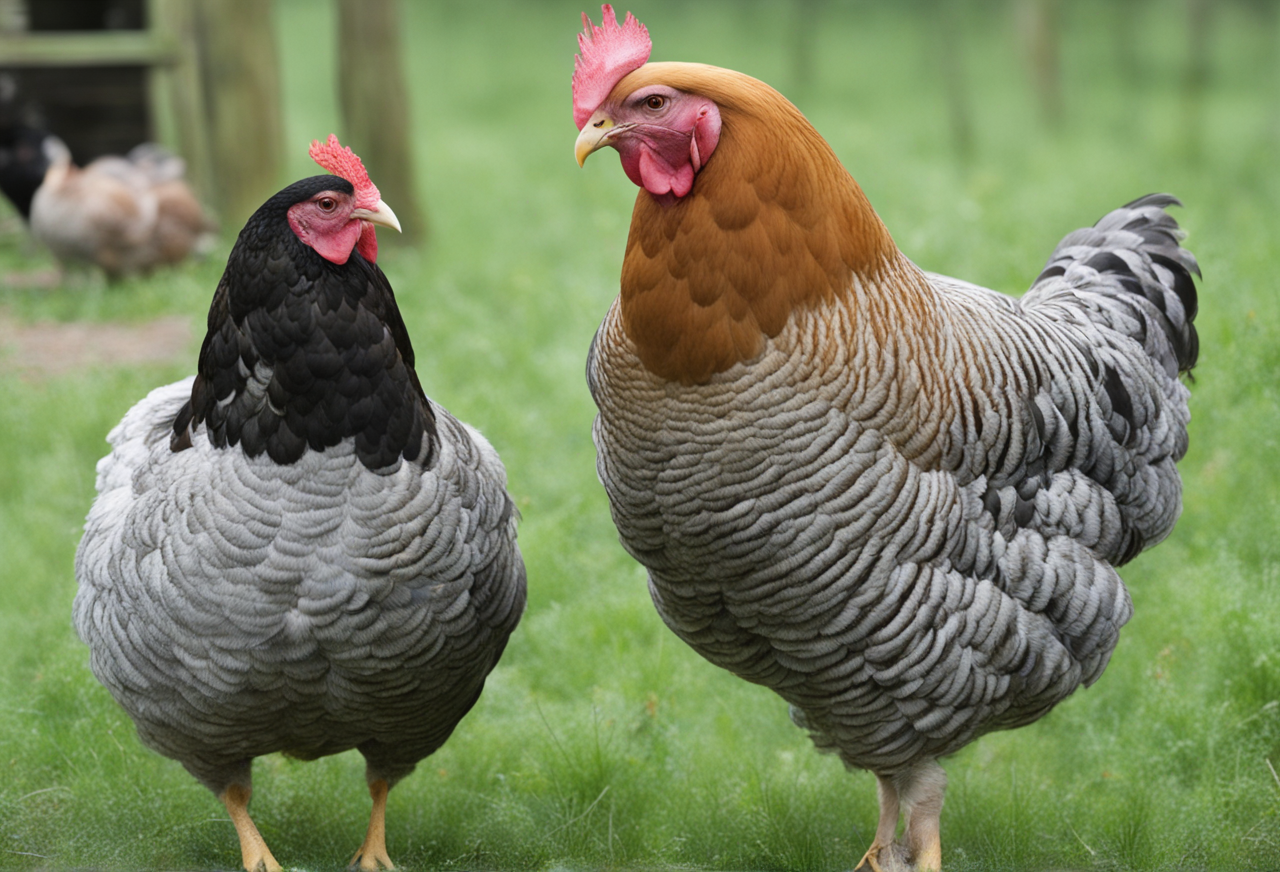As a backyard chicken keeper, I’m often asked which breed is best.
That’s a tough question with no one-size-fits-all answer.
But two popular breeds often top the list: Buff Orpingtons and Barred Rocks
. Both have their pros and cons. So let’s break it down and see which might be the better fit for your flock!
Buff Orpingtons are docile and make great pets. Barred Rocks are excellent layers of large brown eggs.
I’ll never forget the day I brought home my first chicks.
I was so excited to start my journey as a chicken keeper! In my eagerness, I picked up six adorable Buff Orpington chicks from the feed store, without doing much research on the breed.
Rookie mistake, I know!
While my fluffy Orpington chicks quickly grew into hens, I soon realized they were more pet than producer.
Don’t get me wrong, they have endearing personalities, but lagged behind in egg production. If I wanted a steady supply of eggs, I needed a more prolific layer.
Next time around, I did my homework and brought home a mix of breeds, including some Barred Rocks.
Now those girls really churned out the eggs, sometimes 6-7 eggs per hen per week! Needless to say, I was never short on eggs again thanks to my hard-working Barred Rocks.
Here’s an interesting fact about Buff Orpingtons and Barred Rocks – both originated as dual-purpose breeds in the late 1800s, meaning they were valued for both their meat and eggs.
While they share those working origins, their attributes have diverged over time through selective breeding.
So which breed should you choose? Keep reading, and I’ll walk through the key differences between these iconic backyard chickens!
Table of Contents
Appearance
Let’s start with how these breeds look. Buff Orpingtons are known for their fluffy buff-colored feathers covering their big, broad bodies.

They have a heavy, rounded appearance almost like a fluffy pillow! Barred Rocks, on the other hand, are sleeker and have bold black and white stripes across their feathers. They’re an active breed and their appearance reflects that.
If you’re looking for a showy, decorative breed, the Buff Orpington’s good looks can’t be beat. Those fluffy feathers just beg to be petted. But don’t overlook the classic barred pattern of the Barred Rock – they have plenty of visual appeal too.
Temperament
When it comes to personality, Buff Orpingtons are the quintessential gentle giants. They tend to be calm, friendly birds perfect for families with kids or anyone looking for a pet chicken. Don’t expect them to be lap chickens, but they do enjoy human interaction.

Barred Rocks are also friendly birds, but have a bit more spunk and energy to them. They can be very active foragers when let out to free range. Barred Rocks are highly curious and will entertain themselves exploring the yard.
Both breeds can integrate well into mixed flocks. The docile nature of Buff Orpingtons means they tend to be lower in the pecking order. Barred Rocks are more assertive but not aggressive. Just keep an eye out for any bullying.
Egg Production
Here’s where these breeds really differ. Buff Orpingtons lay a moderate amount of light brown eggs, around 3-4 eggs per week. Don’t expect huge numbers from them.

Barred Rocks, on the other hand, are egg-laying machines! You can expect to get up to 5-6 brown eggs per week from each hen. They are consistent layers year-round which makes them hugely popular.
If you’re looking to maximize your egg harvest, Barred Rocks are the clear winner. A small flock of 3-5 hens can keep your egg cartons full. The Buff Orpington is better suited as a pet that happens to lay a few eggs.
Cold Hardiness
In colder climates, buff Orpingtons really shine. Their dense, fluffy feathers provide excellent insulation against winter weather. Birds with heavy feathering also often have small combs and wattles that won’t suffer from frostbite.
Barred Rocks don’t tolerate cold quite as well. Their single combs are prone to frost damage, so need cold weather protection. They are hardy to cold but not to the extent of the Buff Orpington.
If you live in a frigid northern area, the Buff Orpington can take cold snaps in stride. Barred Rocks will need a well-insulated coop and preventative measures for their combs.
Broodiness
Buff Orpingtons are known to be broody chickens, meaning they have a strong natural tendency to sit on a nest of eggs to hatch them. This can be a plus if you want to breed your flock. But for most backyard chicken keepers, broodiness interrupts egg laying which reduces productivity.
You won’t have issues with Barred Rock hens going broody. They use their time and energy strictly toward laying eggs. Of course, you’ll need to provide a rooster and incubate the eggs yourself if you want chicks.
Consider your thoughts on broodiness when comparing these two breeds. For purely egg production, non-broody Barred Rocks have the advantage.
Growth Rate & Meat Production
Remember that both Buff Orpingtons and Barred Rocks were originally bred for dual-purpose use. That means they can provide meat in addition to eggs.
Buff Orpingtons grow quickly and can reach a sizable 7-8 pounds. Their plump feathered bodies provide plenty of delicious meat. Roosters in particular can become massive at 10+ pounds!
Barred Rocks grow at a moderate pace, with hens reaching 6-7 pounds at maturity. Their lean muscular build has decent meat yield. Barred Rock roosters max out around 9 pounds.
So if you want a breed that can pull double duty for both eggs and meat, you can’t go wrong with either. The Buff Orpington may have a slight advantage for meat production thanks to its heavier build.
Feeding Requirements
With any chicken breed, providing a quality feed is key to good health and productivity. Both Buff Orpingtons and Barred Rocks do well on a complete feed formulated for backyard flocks. However, their differing sizes and metabolisms mean they have slightly different nutritional needs.
The heftier Buff Orpington requires more calories per day to support their larger body mass. They have a tendency towards obesity if overfed. Moderating their intake is important, especially for less active hens. Still, Buff Orpingtons are big eaters and will go through more feed than smaller breeds.
Barred Rocks have good feed efficiency, putting the calories towards egg production rather than excessive weight gain. They have good appetite and metabolisms to match their active foraging nature. Barred Rocks are moderate, steady eaters.
Both do well on an all-flock feed of 16-18% protein. This provides Buff Orpingtons the maintenance energy they need without overly fattening. Barred Rocks get sufficient protein for egg production without excess. Supplementing with calcium sources helps strong shell quality.
If you notice your hens becoming overweight or underweight, adjust feed amounts accordingly. Separating breeds is an option for fine-tuned feeding, but not essential in most cases. Simply monitoring body condition and egg output gives you what you need to tweak feed rates.
Housing Needs
Housing your flock properly protects them from the elements and predators. But Orpingtons and Rocks have slightly differing needs when it comes to coop setup.
As a large, fluffy breed, Buff Orpingtons need adequate interior space to move around comfortably. Their feathering insulates them well, but they still benefit from dry bedding and good ventilation. Avoid coops that are cramped or overly humid.
Barred Rocks are more adaptable to coop styles, but also prone to feather picking if overcrowded. Aim for 4 square feet of floor space per standard sized hen. Good perch space reduces crowding. Proper ventilation and litter management are musts for any flock.
Both breeds do fine in cold conditions, but need precautions in heat. Provide shade and cooling ventilation. Free access to the run allows birds to self-regulate in temperature extremes. Just be sure they are safe from predators.
For easy care, clean the coop weekly and replace litter as needed. Check for pests and treat when found. Provide fresh food and water daily. Following best practices for housing any flock keeps them clean, safe, and healthy.
Common Health Issues
In general, both Buff Orpingtons and Barred Rocks are healthy, hardy breeds when properly cared for. But like all chickens, they are susceptible to certain issues.
Orpingtons prone to weight gain can suffer metabolic issues if obese. Excess fat puts strain on the heart and liver. Manage their weight through diet and exercise.
Their puffy feathers can harbor mites and lice. Check regularly for parasites and treat accordingly. Keep coops clean.
Barred Rocks’ large single combs are vulnerable to frost bite in very cold climates. Apply petroleum jelly for protection.
Laying heavily can deplete calcium reserves and lead to thin egg shells. Provide ample layer feed and supplements.
Respiratory issues can happen in crowded coops with poor ventilation or lots of dust and ammonia. Maintain good air quality.
Both breeds can experience common chicken health problems like parasites, infections, and reproductive issues. Offer preventative care and address problems promptly under a vet’s guidance.
Cost
Backyard chickens are an investment upfront, but pay dividends for years through companionship, eggs, pest control, and more. Let’s break down costs.
You’ll pay $3-5 per chick, depending on breeder reputation and region. Some baby chicks may be higher for rarer varieties. Buying started pullets costs more but skips chick brooding.
Basic coop setups start around $300, ranging higher for fancier options. Budget $25+ monthly for quality feed and bedding. Vet costs are situational.
The payback period on hens is 9-12 months when you factor homegrown eggs. After that, eggs are nearly free when you calculate cost per dozen. Meat birds offer additional savings.
Other rewards like gardening help, pet antics, and teaching kids responsibility are priceless. With proper care, backyard hens return value for 10 years or longer.
Barred Rocks may produce eggs at a lower cost per dozen thanks to higher laying rates. But Buff Orpingtons offer more than just eggs. Choose what aligns best with your goals and budget.
Where to Get Them
Finding a reputable source is key when bringing home new chickens. Here are some options for sourcing your Buff Orpingtons or Barred Rocks.
Local farm stores often carry a variety of common breeds. While convenient, quality may vary. Inspect birds closely before purchase.
Chicken swaps let you find birds directly from local breeders. These events are hugely popular in spring. Do your research on any seller.
Order from hatcheries for specific breeds like Blue Laced Red Wyandottes. Hatchery birds are not handled much so need some taming.
Work with a specialty breeder for high quality show birds. Be prepared to pay more for breeding and genetics.
Adopt chickens needing rehoming from sites like Craigslist. Ensure they are healthy and a good fit first.
Never purchase from unethical sources like flea markets. These birds may be ill or become aggressive once mature.
With so many options, you can easily find Buff Orpington or Barred Rock chickens to start or grow your flock. Focus on health, temperament and your goals to pick the best match.
Chick Care
Raising chicks requires preparation and diligent care in their early weeks. While basic needs are the same, the differing growth rates of Buff Orpingtons and Barred Rocks have implications for brooding.
As a larger, quicker growing breed, Buff Orpington chicks need extra space to avoid overcrowding. Allow a minimum of 1 square foot per chick in the brooder setup. Increase as they grow. Barred Rock chicks can start with slightly less space.
Buff Orpington chicks also eat more than smaller breeds. Make sure feeders are easily accessible and keep them well stocked. Check for culls in the flock that may be unable to compete for food.
The heavier feathers of Buff Orpingtons help retain heat. Adjust brooder temperature gradually down to 70°F by week 5. Barred Rocks may need slightly higher and more consistent heat due to lighter feathering.
Work to socialize and handle chicks frequently from day one. This gets them accustomed to human contact. Buff Orpingtons especially benefit from a tame, friendly disposition later on.
For any chicks, focus on providing proper heat, space, sanitation, nutrition, and protection. Monitor for pasty vent, parasites, and illness. With good husbandry, they’ll thrive into adulthood.
Intelligence & Trainability
Chickens are surprisingly intelligent creatures, despite the “bird brain” reputation. Both Buff Orpingtons and Barred Rocks display good instincts, learning abilities, and problem solving skills relative to other backyard chicken breeds.
Buff Orpingtons tend to be calmer and more docile. This can make them slightly easier to train, though they are not as food motivated as active foragers like the Barred Rock. Use favorite treats as positive reinforcement in training.
Barred Rocks are quite curious which lends itself well to hen training. But their energy level means they don’t have the longest attention span. Keep training sessions brief to maintain interest.
Both breeds can learn simple commands like “come” or “step up.” With time, they may let you handle them or walk on a leash. Never force interactions.
Chicken-keeping tasks like getting them into the coop at night or handling for care go smoother with friendly, trained birds. Consistency and patience get the best results.
Overall, Buff Orpingtons and Barred Rocks have comparable intelligence. Their personalities influence trainability more than innate smarts. Work at their level and they’ll impress you.
Predator Vulnerabilities
Protecting your flock from neighborhood and wild predators takes diligence. Their size, temperament and physical abilities contribute to how vulnerable Buff Orpingtons and Barred Rocks are to different threats.
The heftier Buff Orpington struggles more against aerial predators like hawks. Their heavy bodies are less agile taking flight. But they can act aggressively, puffing up to look formidable.
Barred Rocks are lighter and can get airborne faster when threatened from above. Their alert nature helps detect impending attacks. However, they aren’t big enough to fend off large raptors physically.
For ground predators like foxes, both breeds fare similarly. They cannot outrun most mammals, so require secure housing at night. Larger size helps Buff Orpingtons slightly.
Free ranging should only be done in predator-secure spaces. Constant supervision is a must, along with areas to take cover.
Roosters act as lookouts and can defend against some predators. But ultimately, sturdy coops and runs are key to security. Know your local threats and take steps to protect your flock.
Noise Level
When keeping backyard chickens, it’s courteous to neighbors to manage noisy roosters. Hens also can generate ruckus at times. So how loud are our breeds of interest?
Buff Orpingtons are one of the quietest chicken breeds. Hens make modest clucking and egg song when laying. The lovable “teddy bear” personality means they aren’t prone to nervous chatter.
Barred Rock hens aren’t totally silent but don’t have particularly loud voices. Their active foraging leads to occasional egg songs and alert calls. Some individuals crow on occasion.
Roosters of both breeds crow as expected, starting around 4-6 months old. Buff roosters have a lower-pitched, shorter call. Barred Rocks are louder, especially when competing with other roos.
For suburban or urban areas, hens of both breeds generally work. Neighbor noise tolerance varies, so keep flock size modest. Always avoid multiple roosters.
With thoughtfulness to your surroundings, you can enjoy the perks of backyard chickens without ruffling feathers.
Docile Buff Orpingtons and active Barred Rocks can thrive and lay happily (and quietly!).
Feathered Showdown: Buff Orpington vs Barred Rock Chart
| Buff Orpington | Barred Rock | |
|---|---|---|
| Size | Large – hens 7-8 lbs, roosters 10+ lbs | Medium – hens 6-7 lbs, roosters 8-9 lbs |
| Temperament | Calm, docile, friendly | Active, curious, energetic |
| Egg Production | Moderate – 3-4 eggs/week | Excellent – 5-6 eggs/week |
| Egg Color | Light brown | Brown |
| Cold Hardiness | Excellent due to heavy feathering | Moderate, single combs vulnerable |
| Heat Tolerance | Moderate due to heavy feathering | Good |
| Broodiness | Frequently Broody | Rarely Broody |
| Noise Level | Very quiet | Moderate |
| Foraging Ability | Moderate | Excellent, very active |
| Coop Space Needs | 8-10 square feet per bird | 4 square feet per bird |
| Predator Avoidance | Fair, heavy bodies less agile | Good, quite alert and active |
| Feed Efficiency | Moderate | Good |
| Meat Production | Excellent – broad breasted | Good – lean build |
| Growth Rate | Fast | Moderate |
| Climate Tolerance | Prefer cool climates | Wide range from cold to hot |
| Setter or Runner | Setter – prefers confined space | Runner – prefers free range |
| Dropped Wings | Common | Uncommon |
| Brooder Space Needs | 1 sq ft per chick minimum | 0.5 sq ft per chick |
| Trainability | Good, calm nature | Fair, easily distracted |
| Kid Friendliness | Excellent, very tolerant | Good, active |
| Cost | $$$ | $-$$ |
